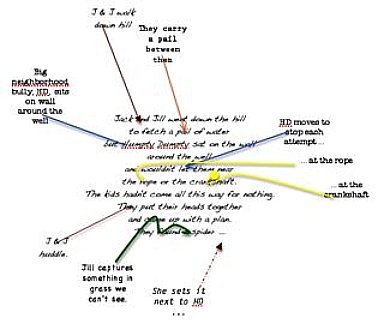|
Comic Book Scriptwriting!
Comic Book scriptwriting begins with strong storytelling. Although the final storytelling in a comic is much more visual that text oriented, the first storytelling in the group has been verbal and theatrical in some of the improvisations.
So far, the creative team has roughed out:
* consensus for comic purpose/genre idea * general length of project * number of frames to include * storytelling ideas from different points of view * a number of characters with names and trait sets. The group now focuses on storytelling ideas to produce a written script. The comic book script is written out in words that tell the story and that describe what is to be drawn. It can help to write the story script down one half of a foolscap
or in the middle of chart paper or chalkboard. In the spaces, flag or number the parts of the story you can picture. Describe that picture in words for your illustration.
To help find illustration potential, your scriptwriting team considers what:
* actions you can illustrate * what struggle/conflict you can illustrate * funny things you might illustrate * genre rules you can explore * location ideas to illustrate that will save you words * season is best for illustrating * time of day your story takes place. If you are stuck, your scriptwriting team can act out that part of the story to see how you can demonstrate:
* action you can illustrate * struggle/conflict you can illustrate * something funny you can include. Is there any research you need to help you illustrate? Revise character pages to see if you can draw each character from all angles. Character detail provides more possibilities for story action and conflict and illustration. Can you add or delete something to make the drawing easier? Clearer? Write the dialogue for each character. Write the captions you will need.
Complete the final script writing of your story frame by frame. Number each frame. Describe the story that is taking place. Describe what each illustration shows. What dialogue will you keep? What narration/caption will you need?
|





